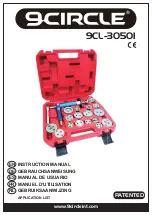
23
english
2. Turn the collar (K) clockwise to lock the dust
bag (J) in place.
TO EMPTY THE DUST BAG
1. While holding the sander, turn the collar (K)
anticlockwise to unlock the dust bag (J).
2. Remove dust bag from the sander and gently
shake or tap the dust bag to empty.
3. Reattach the dust bag back onto the outlet and
lock into place by turning the dust bag collar
clockwise.
You may notice that all the dust will not come
free from the bag. This will not affect sanding
performance but will reduce the sander’s dust
collection efficiency. To restore your sander’s dust
collection efficiency, depress the spring inside the
dust bag when you are emptying it and tap it on the
side of the trash can or dust receptacle.
OPERATION
Instructions for Use
WARNING:
Always observe the safety
instructions and applicable regulations.
WARNING: To reduce the risk of
injury, turn unit off and disconnect
machine from power source before
installing and removing accessories,
before adjusting or changing set-
ups or when making repairs.
Be sure
the trigger switch is in the OFF position.
An accidental start-up can cause injury.
WARNING:
.
• Make sure all materials to be sanded
are well secured.
• Apply only a gentle pressure to the
workpiece. Excessive pressure does
not improve the sanding effect, but
only results in an increased load on
the machine and causes the abrasive
to tear.
• Avoid overloading.
WARNING:
Do not sand magnesium!
Proper Hand Position (Fig. 9A, 9B)
WARNING:
To reduce the risk of
serious personal injury,
ALWAYS
use
proper hand position as shown.
WARNING:
To reduce the risk of
serious personal injury,
ALWAYS
hold
securely in anticipation of a sudden
reaction.
to its locking position. Lock one side clamp
lever (G) by placing it behind the tab (H, Fig. 5)
on the base plate/pad (D) and then repeat with
the second side clamp lever.
5. If you are using the dust extraction feature,
perforate the sandpaper (see
Paper Punch
).
FITTING HOOK AND LOOP SANDING SHEETS (FIG. 6)
1. Place the tool on a table, base plate/pad (D) up.
2. Place the sanding sheet directly on top of the
base plate/pad (D).
3. Hold the base plate/pad with one hand and
align the dust extraction holes (L).
4. Press the sheet firmly onto the base plate/pad.
Paper Punch (Fig. 7)
A paper punch (M) is provided with your sander to
let you perforate regular sandpaper to make dust
collection possible.
TO PERFORATE YOUR SANDPAPER
Install the sandpaper on the tool as instructed in this
manual. With the sander turned off and unplugged,
place the paper punch on the paper so that the
tabs at the edges of the punch are against any two
adjacent sides of the sanding pad, as shown. Press
the punch against the pad so that the 8 points
penetrate the paper, as shown in Figure 7. (Press
the punch into the pad as far as it will go.) Remove
the paper punch and the paper is ready.
An alternate method of perforating the paper is
to securely fasten the punch to a suitable work
surface. Two holes are provided in the punch for this
purpose. Use #8 flat head screws. Press the sander
(with the paper attached) down on the punch.
Dust Extraction (Fig. 1, 8)
WARNING:
Since woodworking with a
sander produces dust, always install a
dustbag designed in compliance with
the applicable directives regarding dust
emission.
WARNING:
Do not use a dustbag or
vacuum extractor without proper spark
protection when sanding metal.
The tool is supplied with an adapter for connecting a
dustbag or a vacuum extractor.
Your sander has a built-in vac-adapter (I) which
allows either the supplied dust bag (J) or a shop
vacuum system to be connected. The built-in outlet
utilizes the D
e
WALT AirLock connection making it
compatible with the D
e
WALT dust extractor.
TO ATTACH THE DUST BAG
1. While holding the sander, fit the dust bag collar
(K) to the vac-adapter (I) as shown in Figure 8.
















































